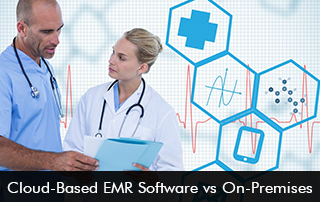EMR Software has revolutionized healthcare by digitizing patient records, streamlining workflows, and improving care coordination. However, healthcare providers face a critical decision when implementing EMR: should they choose a cloud-based or on-premises solution?
This blog explores both deployment models’ key differences, benefits, and drawbacks to help you make an informed decision.
What Is EMR Software?
Electronic Medical Record Software is a digital system that stores, manages, and retrieves patient medical records. It replaces paper charts, enabling healthcare providers to track patient data over time, monitor treatment plans, and improve clinical decision-making.
Key Features of EMR Software
-
Patient charting and documentation
-
e-Prescribing and medication management
-
Lab integration and diagnostic tools
-
Billing and claims processing
-
Telehealth and remote patient monitoring
Cloud-Based EMR Software
Cloud-based EMR (or SaaS EMR) is hosted on remote servers and accessed via the internet. Providers pay a subscription fee, and the vendor handles maintenance, updates, and security.
Advantages of Cloud-Based EMR Software
1. Lower Upfront Costs
-
No need for expensive hardware or server infrastructure.
-
Subscription-based pricing reduces initial investment.
2. Scalability & Flexibility
-
Easily scales as your practice grows.
-
Accessible from anywhere with an internet connection.
3. Automatic Updates & Maintenance
-
Vendors handle software updates, ensuring compliance with the latest regulations.
-
No need for in-house IT staff to manage servers.
4. Enhanced Security & Disaster Recovery
-
Cloud providers use advanced encryption and backup protocols.
-
Data is stored securely in multiple locations, reducing the risk of loss.
Disadvantages of Cloud-Based EMR Software
1. Dependence on Internet Connectivity
-
Requires a stable internet connection for full functionality.
-
Downtime can disrupt workflows.
2. Ongoing Subscription Costs
-
Monthly or annual fees may add up over time.
-
Less control over long-term pricing changes.
3. Limited Customization
-
Some cloud-based EMR systems have restrictions on modifications.
On-Premises EMR Software
On-premises EMR is installed locally on a healthcare organization’s own servers. The provider is responsible for maintenance, security, and updates.
Advantages of On-Premises EMR Software
1. Full Control Over Data & Infrastructure
-
Data remains within the organization’s physical control.
-
Ideal for facilities with strict compliance requirements.
2. No Ongoing Subscription Fees
-
One-time licensing fee (though maintenance costs apply).
-
Long-term cost savings for large healthcare systems.
3. Customization & Integration Flexibility
-
Can be tailored to specific workflows and legacy systems.
-
Easier integration with other on-site software.
4. No Internet Dependency
-
Works offline, ensuring uninterrupted access.
Disadvantages of On-Premises EMR Software
1. High Upfront Costs
-
Requires significant investment in servers, IT staff, and infrastructure.
2. Maintenance & Updates Are Your Responsibility
-
The IT team must handle patches, security, and compliance updates.
-
Risk of falling behind on critical updates.
3. Limited Remote Access
-
Accessing records remotely may require VPNs or additional setups.
4. Disaster Recovery Risks
-
If servers fail, data recovery depends on internal backups.
Key Differences Between Cloud-Based & On-Premises Software
| Feature | Cloud-Based EMR | On-Premises EMR |
|---|---|---|
| Cost Structure | Subscription-based (monthly/annual) | One-time license + maintenance |
| Deployment | Hosted on the vendor’s servers | Installed on local servers |
| Maintenance | Handled by vendor | Managed in-house |
| Accessibility | Anytime, anywhere (with internet) | Limited to on-site or VPN access |
| Scalability | Easily scalable | Requires hardware upgrades |
| Security | Vendor-managed encryption & backups | Internal IT controls security |
Which EMR Software Is Right for You?
Choose Cloud-Based EMR If:
✔ You want lower upfront costs.
✔ Your practice needs remote access and flexibility.
✔ You lack in-house IT resources.
✔ You prefer automatic updates and security.
Choose On-Premises EMR If:
✔ You need full control over data security.
✔ Your organization has strict compliance needs.
✔ You have the budget for hardware and IT staff.
✔ You require deep customization.
The Future of EMR Software
The healthcare industry is increasingly shifting toward cloud-based EMR due to its cost efficiency, accessibility, and AI-driven innovations. However, some large hospitals and government facilities still prefer on-premises solutions for regulatory reasons.
Hybrid models are also emerging, allowing providers to store sensitive data on-premises while using the cloud for scalability.
Both cloud-based and on-premises EMR have unique advantages. Smaller practices and those needing flexibility often benefit from cloud solutions, while large healthcare systems with robust IT infrastructure may prefer on-premises deployments.
Before making a decision, assess your budget, IT capabilities, security needs, and long-term goals. The right EMR will enhance efficiency, improve patient care, and ensure compliance with healthcare regulations.








